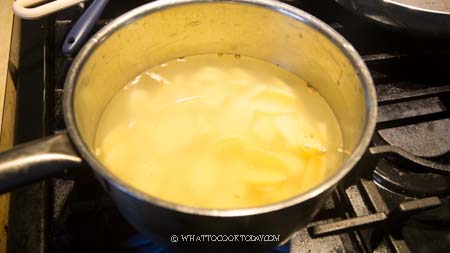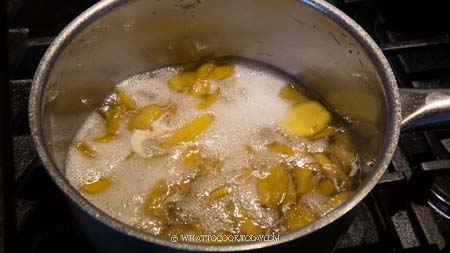This post may contain affiliate links. Please read our disclosure policy.
You can easily make candied ginger and crystallized ginger at home. They are so much better and are not difficult to make at all.

The holiday season is in the air now. The cold crisp air, the smell of spices, dried fruits, candied fruits! Christmas is just around the corner! Looking at some holiday baking recipes, I saw some recipes that called for candied ginger and I happened to just buy some fresh ginger.
Are candied ginger and crystallized ginger the same thing?
This is probably one of the questions that people ask the most, including myself. Candied ginger and crystallized ginger are terms that are often used interchangeably, but they are finished differently. The process of making them started out the same, by boiling the ginger in sugar syrup. To make the candied ginger, you can store the ginger in the syrup OR you can remove the ginger from the syrup to let it “dry” but still sticky to the touch. To make crystallized ginger, you take these “dried out” candied ginger and coat them in sugar. That’s your crystallized ginger.
What kind of ginger to use
You want to use fresh ginger, preferably the young ones because they are more tender and less fibrous. Old ginger works too, they are just tougher and more fibrous. How can you tell if the ginger root is young or old ? Well, it’s not as obvious, but usually young ginger has thinner skin and easier to peel. The young ones are also juicier and less spicy. The old ones have thicker skin and more difficult to peel because they are fibrous too. The old ones are also spicier.
Why make your own
When you make your own, you get to control how “spicy” the ginger you want to be. You can also choose what shapes you want them to be, slices or cubes or strips. They only need 2 ingredients! well, 3 if you count the water! The rest is just passive time to dry the ginger out.
How to use candied ginger and crystallized ginger
Both candied and crystallized ginger can be used in similar ways, such as in baking, cooking, or as a standalone snack. They can add a sweet and spicy flavor to a variety of dishes. My kids like to snack on crystallized ginger (yes, the one coated with sugar LOL!). I also like to snack on candied ginger or add them to my tea.
How to Make Candied Ginger and Crystallized Ginger
Ingredients
- 225 g fresh ginger
- 400 g granulated sugar plus more for coating
- 480 ml water
Instructions
Prepare the ginger:
- Wash the ginger root with water to get rid of sand and dirt. Pat dry with a paper towel. Ginger roots can have lots of nooks and can be difficult to peel using a regular peeler. Use a sturdy metal spoon, with the back of the spoon facing outward, scrape the skin in a motion away from you, using the tip of the spoon.
- Use a sharp large knife to cut the ginger into about 1/4-inch slices. Some people like to cut into little cubes (the meaty chewy texture is great for snacking). You can use a mandoline slicer to make your life easier
Blanch the ginger:
- This part is to eliminate some of the intense spiciness of ginger. It also helps to make the texture soft and chewy later
- Place the ginger in a medium-size saucepan. Add water, enough to cover the ginger. Bring to a boil and then lower the heat to medium to let it simmer for 10 minutes. I usually stop here because I like my candied ginger to be spicy. If you want it less spicy, discard the boiling water, fill up with a new one and boil again for another 10-15 minutes.
- I usually keep the boiling liquid because it makes a very spicy ginger tea, which I like.
Cook ginger in syrup:
- Add sugar and water in a saucepan. Bring to a boil and then add the blanched ginger. Lower the heat to medium and let them simmer until it reaches a temperature of 225 F (107 C). When it reaches this temperature, we know that most of the water has evaporated, leaving you with a nice thickened syrup. If you don't have a thermometer, I suggest you get one, it takes out the guesswork and an instant-read thermometer is a useful kitchen gadget anyway. Otherwise, you can boil for about 45 minutes or so or until the syrup has thickened
To make candied ginger:
- You can leave the ginger slices stored in the syrup or you can proceed to the next step to make crystallized ginger
- You can also remove the candied ginger from the syrup but not coating them in sugar (to make crystallized ginger). I prefer them without the sugar-coating for snacking. Let them dry out on a cooling rack overnight. They are still sticky to the touch but shouldn't be drippy or wet anymore
To make crystallized ginger:
- Leave the ginger in the syrup for one hour and then drain the ginger using a mesh strainer and let them drain for about 30 minutes. I usually keep the syrup. So I make sure to have another pot underneath to collect the syrup while draining. They are great for coffee, tea, desserts, waffles, pancakes, etc.
- Lay the pieces of ginger on a cooling rack with parchment paper underneath in case some syrup are still dripping. Let them air dry for 2-3 hours. You don't want them to be too dry or too wet. Too dry and the sugar won't stick to the ginger. Too wet and the sugar coating melts
- Then coat each piece of dried out candied ginger in sugar and lay those pieces back on the cooling rack to let them dry out completely. I usually just left them out overnight
Storage:
- Store the crystallized ginger in an air-tight container at a cool dark place, away from direct sunlight for several months.
- Store the candied ginger in syrup in the fridge for a month or longer. Store the dried out candied ginger (not stored in syrup) in an air-tight container. They can be kept at a cool dark place at room temperature for few months
RECOMMEDED TOOLS
Marv’s Recipe Notes
*Nutrition facts are just estimates and calculated using online tools*

How to make candied ginger and crystallized ginger
1. Wash the ginger root with water to get rid of sand and dirt. Pat dry with a paper towel. Ginger roots can have lots of nooks and can be difficult to peel using a regular peeler. Use a sturdy metal spoon, with the back of the spoon facing outward, scrape the skin in a motion away from you, using the tip of the spoon.
2. Use a sharp large knife to cut the ginger into about 1/4-inch slices. Some people like to cut into little cubes (the meaty chewy texture is great for snacking). You can use a mandoline slicer to make your life easier
3. Place the ginger in a medium-size saucepan. Add water, enough to cover the ginger. Bring to a boil and then lower the heat to medium to let it simmer for 10 minutes. 

4. Then discard the boiling liquid. I usually keep the boiling liquid because it makes a very spicy ginger tea, which I like. I usually stop here because I like my candied ginger at a spicier side.
If you want it less spicy, discard the boiling water, fill up with a new one and boil again for another 10-15 minutes.
5. Add sugar and water in a saucepan. Bring to a boil and then add the blanched ginger. Lower the heat to medium and let them simmer until it reaches a temperature of 225 F (107 C). When it reaches this temperature, we know that most of the water has evaporated, leaving you with a nice thickened syrup. If you don’t have a thermometer, I suggest you get one. Otherwise, you can boil for about 45 minutes or so or until the syrup has thickened. I strongly suggest that you get a thermometer (it takes out the guesswork)

6. To make candied ginger, leave the ginger slices stored in the syrup, You can also remove the candied ginger from the syrup but not coating them in sugar (to make crystallized ginger). I prefer them without the sugar-coating for snacking. Let them dry out on a cooling rack overnight. They are still sticky to the touch but shouldn’t be drippy or wet anymore

7. Leave the ginger in the syrup for one hour and then drain the ginger using a mesh strainer and let them drain for about 30 minutes. I usually keep the syrup. So I make sure to have another pot underneath to collect the syrup while draining. They are great for coffee, tea, desserts, waffles, pancakes, etc.

8. Lay the pieces of ginger on a cooling rack with parchment paper underneath in case some syrup are still dripping. Let them air dry for 2-3 hours. You don’t want them to be too dry or too wet. Too dry and the sugar won’t stick to the ginger. Too wet and the sugar coating melts. Then coat each piece of dried-out candied ginger in sugar and lay those pieces back on the cooling rack to let them dry out completely. I usually just left them out overnight

Did you make this candied ginger and crystallized ginger recipe?
I love it when you guys snap a photo and tag it to show me what you’ve made. Simply tag me @WhatToCookToday #WhatToCookToday on Instagram and I’ll be sure to stop by and take a peek for real!



